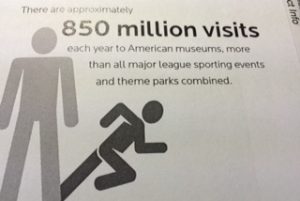And now it’s alright, it’s okay
And you may look the other way
We can try to understand
the New York Times’ effect on man.
Stayin’ Alive. The Gibbs Brothers
Monday, February 27 was training day for the 9th annual American Alliance of Museums Advocacy Day program; two days when museums from all over the country network, train, and meet with members of Congress or their staff to make the case for the value of museums. I’ve attended a number of Advocacy Days over the years, and the program has continued to grow in efficacy, in organization, and in the kinds of resources and congressional connections it provides for museums. Three hundred fifty museum professionals attended this year’s training, up 50% from last year. And with good reason.
Training for Advocacy
First we heard encouraging words about the value of museums and the current level of support from top officials of the National Endowment for the Arts (NEA), the National Endowment for the Humanities (NEH), the US Department of Education, and the Institute for Museum and Library Services (IMLS). They spoke only of current policy up to this time, and did not speculate on the impact of the current administration on cultural organizations more broadly, and on museums, zoos, aquariums, etc. in particular.

A graphic from information materials that AAM delegates can leave with Congressional offices.
Then came a Call to Action by Tim Delaney, President and CEO of the National Council of Nonprofits, who received notice during his presentation that Trump’s budget had been announced. The PowerPoint slide he had prepared already listed the following White House spending priorities:
- Increase in defense spending
- Increase in infrastructure spending
- Big tax cuts
- $20+ billion for the Wall
- __________________
- Massive cuts in domestic programs
- Block grants to the states for many programs
The last two will affect both federal and state funding for cultural organizations. According to Delaney, the states receive 30% of their revenue from the federal government, and (here’s where he got the text about the budget) the 10% increase in defense spending is partly coming out of a 10% decrease in domestic spending. So cut 10% off of state revenues as well as all other federal domestic spending. See the Washington Post’s Catherine Rampell recent op ed: ‘America First’ Really Means ‘Americans Last.’ Simply put, the bottom two priorities will help pay for the top four. But since the funding for the bottom two is so small compared with the top four, especially defense spending, even more money will have to be found somewhere. Rampell mentions the Corporation for Public Broadcasting and the endowments, but also programs such as food stamps, Medicaid, housing assistance, and foreign aid. Delaney also pointed out that changes in the Affordable Care Act will very likely affect spending on cultural organizations, especially as more costs of ACA could be shifted to the states. Delaney’s final message: STAND UP AND FIGHT for your mission. Speak civilly but forcefully for the cultural sector. There is strength in numbers.
Planning and action
Of course the budget has not yet been passed by Congress, so here’s where Advocacy Day can be important. AAM’s Elizabeth Merritt led us through some contingency planning exercises during lunch, and encouraged all to begin thinking of a) specific consequences of budget cuts; and b) specific ways to counteract these. It will take months, perhaps a year, for many of the proposed cuts to be enacted. Now is the time to plan. During the afternoon the AAM team that works year-round on Congressional relations provided talking points and specific, focused “asks, e.g. the reauthorization for funding for IMLS. Leading up to Advocacy Day, AAM staff arranges appointments with Members of Congress, or more likely, their staff members who work on cultural issues, matching museums with their appropriate Congressional districts. On Tuesday, February 28, museum folk fanned out across the Capitol, carrying printed versions of the IMLS ask as well as information on the ways in which their organizations contribute to the quality of life and the economies of their communities.
For those unable to attend Advocacy Day, be sure to go to the Alliance link for all kinds of useful information on how to advocate for your organization. Some of the materials are for members only, but a great many appear to be available to all. You can also contact Ember Farber efarber@aam-us.org or Ben Kershaw bkershaw@aam-us.org about email updates on when museum related legislation is moving forward, i.e. the optimum time to contact your Member of Congress. Also like AAM at facebook.com/americanmuseums.
The Elephant in the Room
Based on my Twitter and Facebook feeds from colleagues, and on conversations I’ve had at recent regional museum conferences as well as on Advocacy Day, I see two key questions looming for museum professionals today:
- How can our institutions remain relevant and viable in the face of almost certain budget cuts? How can we plan? What can we do?
- What is our role as cultural institutions during a time when a free press is denigrated, when xenophobia, racism, and intolerance appear to be on the rise and even encouraged by those in power, when the veracity of science is questioned?
Advocacy Day did much to address the first question. It was perhaps not within its scope to address the second, but it is very much on peoples’ minds. My next post will examine this second question. Stay tuned, send thoughts. I’ll post soon.
If you are receiving this post by email and wish to comment, please go to www.museumcommons.com or send a tweet to me @gretchjenn.
.